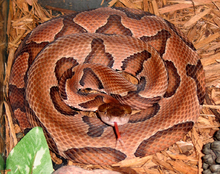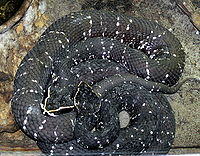User:Chrisf1020/sandbox/Agkistrodon
| Agkistrodon | |
|---|---|

| |
| Copperhead, A. contortrix | |
| Scientific classification | |
| Domain: | Eukaryota |
| Kingdom: | Animalia |
| Phylum: | Chordata |
| Class: | Reptilia |
| Order: | Squamata |
| Suborder: | Serpentes |
| Family: | Viperidae |
| Subfamily: | Crotalinae |
| Genus: | Agkistrodon Palisot de Beauvois, 1799 |
| Synonyms | |
Agkistrodon is a genus of venomous pit vipers found in North America from the United States south to northern Costa Rica.[1] Eight species are currently recognized,[2] all of them monotypic and closely related.[3] Common names include: cottonmouths, copperheads, cantils, and moccasins.
Name origin
[edit]The name Agkistrodon comes from the Greek words agkistron (ἄγκιστρον, 'fishhook', with the irregular transliteration gk rather than the usual nk) and odous (ὁδοὐς, 'tooth,' from the stem ὁδόντ-) and is likely a reference to the fangs.[4]
Some varieties of the genus are given the common name "moccasin" or "moccasin snake" in the United States, which is the Algonquian word for "shoe". The origin of this nickname is unknown. The first known use of "moccasin" to refer to a deadly venomous snake was in a 1765 publication. The nickname is used to refer to both cottonmouths and copperheads. According to the Word Detective, this use may be related to their color and appearance or the silence with which they move.[5] Another source for this name may be the Native American word "mokesoji" of unknown origin and meaning.[6]
Description
[edit]Members of this genus have a number of features in common. All species have a relatively broad head with short fangs. A loreal scale is present, except in A. piscivorus. Usually, nine large symmetrical platelike scales are on the crown of the head, but in all species, these are often irregularly fragmented or have sutures, especially in A. bilineatus. All have a sharply defined canthus rostralis and a vertically elliptical pupil. Usually eight (6-10) supralabial scales and usually 10-11 (8-13) sublabials are present. The dorsal scales are mostly keeled and at midbody number 21-25 (usually 23), while A. piscivorus has 23-27 (usually 25). The snake has 127-157 ventral scales and 36-71 subcaudals. Of the latter, some may be divided. The anal scale is single. All have a color pattern of 10-20 dark crossbands on a lighter ground color, although sometimes the crossbands are staggered as half bands on either side of the body.[4]
Geographic range
[edit]They are found in North America from the northeastern and central United States southward through peninsular Florida and southwestern Texas, and in Central America on the Atlantic versant from Tamaulipas and Nuevo León southward to the Yucatan Peninsula, Belize, and Guatemala. They are seen along the Pacific coastal plain and lower foothills from Sonora south through Guatemala, El Salvador, Honduras, and Nicaragua to northwestern Costa Rica.[1]
Behavior
[edit]All are semiaquatic to terrestrial and are often found near sources of water. However, A. contortrix and A. bilineatus are also found in dry habitats, often far from permanent streams or ponds.[4]
Reproduction
[edit]The members of this genus are all ovoviviparous.[4]
Venom
[edit]Pit vipers of the genus Agkistrodon rely on a potent venom they produce for their survival. Used to immobilize prey and fend off predators, one bite can inject enough venom into a human to cause severe pain, swelling, weakness, difficulty breathing, hemorrhaging, gangrene, fever, vomiting, and in rare instances, even death.[7]
The venom of all three species is assumed to be not unlike that of A. contortrix, which contains thrombin-like enzymes that act upon the coagulant activity of the blood. A study of electrophoretic patterns of proteins in venoms among and within populations of A. contortrix and A. piscivorus showed that substantial variation exists,[8] and no reason exists to believe that these differences do not correspond with variations in toxicity.[4]
Research
[edit]In a study conducted at the College of Medicine at the University of Florida, venom from A. piscivorous was injected into the lymph fluid of a frog. The frog immediately suffocated because of the collapse of its lung sacs. The venom even resulted in lung constriction when directly applied to the surface of the frog's lungs. To test this, trace amounts of venom were dropped onto a single pulmonary sac in a frog's lung after it was anesthetized and its chest cavity dissected open. A drop of solution containing a venom concentration of 1 mg/ml was enough to cause contraction of the pulmonary artery adventitia after 5-8 sec in a frog weighing 40 g.[9] The study found, however, that this toxic effect is simply a tool the snake can choose to employ from an accessory venom gland it has. In most instances, the viper injects a venom that tends to immobilize, not kill, its prey before ingestion. In this case, the main venom glands secrete a toxin that inhibits the prey’s sympathetic response to flee or fend off its predator. This essentially stuns the animal so that the predator can easily attack.[9]
Species
[edit]| Image | Species[2] | Taxon author[2] | Subsp.[2] | Common name | Geographic range[1][2][10] |
|---|---|---|---|---|---|

|
A. bilineatus | (Günther, 1863) | 0 or 1* | cantil Mexican cantil Mexican ground pit viper Mexican yellow-lipped viper cantil viper Mexican moccasin black moccasin neotropical moccasin |
Mexico (southern Sonora, Sinaloa, Nayarit, Jalisco, Morelos, Colima, Michoacan, Guerrero, Oaxaca, Chiapas, Puebla), Guatemala, El Salvador, western Honduras. |
| A. conanti | (Gloyd, 1969) | 0 | Florida cottonmouth | United States (Florida, southern Georgia). | |

|
A. contortrix | (Linnaeus, 1766) | 0 | copperhead eastern copperhead |
United States (Texas, eastern Oklahoma, eastern Kansas, Missouri, Arkansas, Louisiana, Mississippi, Alabama, Georgia, Florida, South Carolina, North Carolina, Tennessee, Kentucky, Virginia, West Virginia, southern Illinois, southern Indiana, southern Ohio, Iowa, Pennsylvania, Maryland, New Jersey, Delaware, southern New York, Connecticut, Massachusetts), Mexico (northeastern Chihuahua, northern Coahuila). |
| A. howardgloydi | (Conant, 1984) | 0 | Gloyd's moccasin Gloyd's cantil southern cantil |
Northwestern Costa Rica, western Nicaragua, southern Honduras. | |
| A. laticinctus | (Gloyd & Conant, 1934) | 0 | broad-banded copperhead | United States (central to north-central Texas, into central Oklahoma, to northern Kansas). | |

|
A. piscivorus | (Lacépède, 1789) | 0 | cottonmouth water moccasin worm-tailed pit viper |
United States (Texas, southeastern Oklahoma, southern Missouri, Arkansas, Louisiana, Mississippi, Kansas, Alabama, Georgia, Florida, South Carolina, eastern North Carolina, western Tennessee, western Kentucky, southern Illinois, Indiana, southeastern Virginia). |
| A. russeolus | (Gloyd, 1972) | 0 | Yucatecan cantil | Mexico (Campeche, Yucatan, Quintana Roo), northern Guatemala, northern Belize. | |

|
A. taylori | (Burger & Robertson, 1951) | 0 | Mexican moccasin Taylor's cantil ornate cantil |
Mexico (Tamaulipas, Nuevo León, San Luis Potosi, Hidalgo, northern Veracruz). |
*Status of A. b. lemosespinali remains uncertain.
Taxonomy
[edit]The phylogeny of the species in this genus has long been controversial. Studies based on morphological[3] and venom characteristics[8] support the idea that the A. bilineatus species complex (including former subspecies A. howardgloydi, A. russeolus, and A. taylori) and A. contortrix species complex (including former subspecies A. laticinctus) are more closely related. However, an analysis of mitochondrial DNA,[11] as well as more recent molecular studies,[12][13] have concluded that the A. bilineatus species complex and the A. piscivorus species complex (including A. conanti) are sister taxa, with A. contortrix being a sister species to them both.[4]
This genus was previously much larger and also included the following genera:[1]
- Calloselasma - Ground pit viper found in Southeast Asia (Malaya).
- Deinagkistrodon - The Hundred-pace viper found mostly in southern China.
- Gloydius - Ground pit vipers found in Asia.
- Hypnale - Hump-nosed vipers found in India and Sri Lanka.
References
[edit]- ^ a b c d e McDiarmid RW, Campbell JA, Touré T. 1999. Snake Species of the World: A Taxonomic and Geographic Reference, vol. 1. Herpetologists' League. 511 pp. ISBN 1-893777-00-6 (series). ISBN 1-893777-01-4 (volume).
- ^ a b c d e "Agkistrodon". The Reptile Database. www.reptile-database.org.
- ^ a b Gloyd HK, Conant R. 1990. Snakes of the Agkistrodon Complex: A Monographic Review. Society for the Study of Amphibians and Reptiles. 614 pp. 52 plates. LCCN 89-50342. ISBN 0-916984-20-6.
- ^ a b c d e f Campbell JA, Lamar WW. 2004. The Venomous Reptiles of the Western Hemisphere. Comstock Publishing Associates, Ithaca and London. 870 pp. 1500 plates. ISBN 0-8014-4141-2.
- ^ "Moccasin". The Word Detective. January 2014. Retrieved November 21, 2016.
- ^ Catherine C. Hopley (1882). Snakes: curiosities and wonders of serpent life. London, Griffith & Farran; New York, E.P. Dutton & co.
Besides that 'deadly moccasin' and frequent 'black snakes,' there were 'whip snakes,' 'milk snakes,' and many others which the negroes would bring home as trophies of their courageous slaughter; but by no scientific names were they known there. Except this name moccasin or mokesoji, which probably conveyed some especial meaning to the aborigines, few of the Indian vernaculars have been preserved in the United States, as we find them in other parts of America, which latter are treated of in chapters xxii. and xxiii. of this work ; but common English names prevail.
- ^ "Agkistrodon acutus pit vipers." Medical-Explorer.com; accessed April 2010. [1]
- ^ a b Jones JM (1976). "Variation of venom proteins in Agkistrodon snakes from North America". Copeia. 1976 (3): 558–562. doi:10.2307/1443375.
- ^ a b Gennaro JF, Hall HP, Casey ER, Hayes WK (September 2007). "Neurotropic effects of venoms and other factors that promote prey acquisition". Journal of Experimental Zoology. Part a, Ecological Genetics and Physiology. 307 (9): 488–99. doi:10.1002/jez.405. PMID 17620305.
- ^ Savage, JM. The Amphibians and Reptiles of Costa Rica. The University of Chicago Press, 2002, p. 719. ISBN 0-226-73537-0.
- ^ Knight A, Densmore III LD, Real ED (1992). "Molecular systematics of the Agkistrodon complex". pp. 49-70. In: Campbell JA, Brodie Jr ED (1992). Biology of the Pitvipers. Texas: Selva. 467 pp. 17 plates. ISBN 0-9630537-0-1
- ^ Parkinson CL (1999). "Molecular systematics and biogeographical history of pitvipers as determined by mitochondrial ribosomal DNA sequences". Copeia. 1999 (3): 576–586. doi:10.2307/1447591.
- ^ Parkinson CL, Moody SM, Ahlquist JE (1997). "Phylogenetic relationships of the "Agkistrodon complex" based on mitochondrial DNS data". pp. 63-78. In: Thorpe RS, Wüster W, Malhotra A (1997). Venomous Snakes: Ecology, Evolution, and Snakebite. Oxford: Clarendon Press
